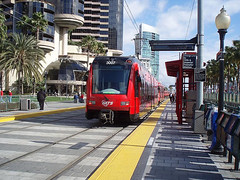Transit ridership continues to soar

Posted June 3, 2008 at 6:55PM
The American Public Transportation Association (APTA) announced yesterday that Americans took 2.6 billion trips on public transportation in the first three months of 2008. This is almost 85 million more trips than last year for the same time period.
 This continues and strengthens the trend that I reported here earlier this year, with public transportation use as of the end of 2007 up 32 percent since 1995, a rate double that of population increase and substantially higher than the rate of increase in driving during that same period.
This continues and strengthens the trend that I reported here earlier this year, with public transportation use as of the end of 2007 up 32 percent since 1995, a rate double that of population increase and substantially higher than the rate of increase in driving during that same period.
Now, of course, driving by Americans is actually declining. APTA cites Federal Highway Administration data to report that in the first quarter of 2008, vehicle miles traveled on our nation’s roads declined by 2.3 percent. (This also continues a trend reported here.) Meanwhile, public transportation use continued to climb and rose by 3.3 percent in the first quarter.
Using the APTA data, The Washington Post reports that light rail and commuter rail systems have shown the biggest increases in ridership, with spectacular numbers in some locations:
“Among light-rail systems, Baltimore recorded a 16.8 percent increase in the first quarter, Minneapolis went up 16.4 percent, St. Louis increased 15.6 percent and San Francisco rose 12.2 percent.
“Commuter rail posted the second largest ridership increase at 5.7 percent. The six commuter rail systems with a double-digit ridership growth rate in the first three months of 2008 were in Seattle (27.9 percent), Harrisburg, Pa. (17 percent), Oakland, Calif. (15.8 percent), Stockton, Calif. (13.9 percent), Pompano Beach, Fla. (12.9 percent) and Philadelphia (10.4 percent).
“In the Washington area, the transit agencies that provide longer-haul trips are experiencing significant ridership increases. Loudoun County's commuter bus system posted a 23 percent increase in April over the same period last year. Ridership was also up 12 percent in April on Virginia Railway Express, and the Maryland Transit Administration reported a 15 percent increase in ridership in April on the 15 commuter routes into Washington.”
Heavy rail systems such as Washington’s Metro and New York’s subway have also shown significant increases in ridership from 4-9 percent over the same time period last year.
One consequence is that our transit systems are now overburdened. With the omnibus bill that governs federal transportation funding coming up for renewal, we must allocate maximum resources to improving public transportation capacity.
 All this has everything to do with gasoline prices, of course. People living or working in sprawl locations are bearing the greatest burden, which is a major reason why housing in sprawl is losing value while housing in more urban locations with shorter commutes is holding value. But it also has to do with the readiness of Americans for new patterns of living that will include shorter, more convenient travel patterns and less time in our cars. And, at the policy level, it has to do with the need to reduce greenhouse gas emissions.
All this has everything to do with gasoline prices, of course. People living or working in sprawl locations are bearing the greatest burden, which is a major reason why housing in sprawl is losing value while housing in more urban locations with shorter commutes is holding value. But it also has to do with the readiness of Americans for new patterns of living that will include shorter, more convenient travel patterns and less time in our cars. And, at the policy level, it has to do with the need to reduce greenhouse gas emissions.
It’s very tempting to proclaim victory and say the tipping point has finally been reached, sprawl is done, smart growth has won. But I’m waiting for the superdelegates before saying so.
RIP Bo Diddley, 1928-2008:
Bo Diddley, Bo Diddley, where you been? (chunk-a-chunk-chunk, chunk-chunk)
Round the world and back again (chunk-a-chunk-chunk, chunk-chunk)